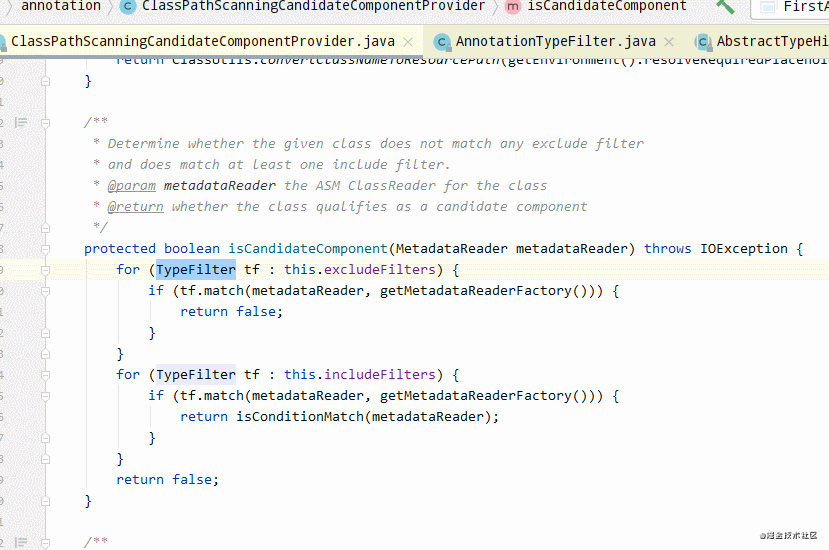@Component,@Service等注解是如何被解析的?
作者 :Jitwxs ,链接: https://jitwxs.cn/4135e0a9.html
前言
@Component和@Service都是工作中常用的注解,Spring如何解析?
1.@Component解析流程
找入口
Spring Framework2.0开始,引入可扩展的XML编程机制,该机制要求XML Schema命名空间需要与Handler建立映射关系。
该关系配置在相对于classpath下的/META-INF/spring.handlers中。

如上图所示 ContextNamespaceHandler对应context:... 分析的入口。
找核心方法
浏览ContextNamespaceHandler

在parse中有一个很重要的注释
// Actually scan for bean definitions and register them.ClassPathBeanDefinitionScanner scanner = configureScanner(parserContext, element);
大意是:ClassPathBeanDefinitionScanner#doScan是扫描BeanDefinition并注册的实现 。
ClassPathBeanDefinitionScanner 的源码如下:
protected Set doScan(String... basePackages) {
Assert.notEmpty(basePackages, "At least one base package must be specified");
Set beanDefinitions = new LinkedHashSet<>();
for (String basePackage : basePackages) {
//findCandidateComponents 读资源装换为BeanDefinition
Set candidates = findCandidateComponents(basePackage);
for (BeanDefinition candidate : candidates) {
ScopeMetadata scopeMetadata = this.scopeMetadataResolver.resolveScopeMetadata(candidate);
candidate.setScope(scopeMetadata.getScopeName());
String beanName = this.beanNameGenerator.generateBeanName(candidate, this.registry);
if (candidate instanceof AbstractBeanDefinition) {
postProcessBeanDefinition((AbstractBeanDefinition) candidate, beanName);
}
if (candidate instanceof AnnotatedBeanDefinition) {
AnnotationConfigUtils.processCommonDefinitionAnnotations((AnnotatedBeanDefinition) candidate);
}
if (checkCandidate(beanName, candidate)) {
BeanDefinitionHolder definitionHolder = new BeanDefinitionHolder(candidate, beanName);
definitionHolder =
AnnotationConfigUtils.applyScopedProxyMode(scopeMetadata, definitionHolder, this.registry);
beanDefinitions.add(definitionHolder);
registerBeanDefinition(definitionHolder, this.registry);
}
}
}
return beanDefinitions;
} 上边的代码,从方法名,猜测:
findCandidateComponents:从classPath扫描组件,并转换为备选BeanDefinition,也就是要做的解析@Component的核心方法。推荐:Java面试练题宝典
概要分析
findCandidateComponents在其父类ClassPathScanningCandidateComponentProvider 中。
public class ClassPathScanningCandidateComponentProvider implements EnvironmentCapable, ResourceLoaderAware {
//省略其他代码
public Set findCandidateComponents(String basePackage) {
if (this.componentsIndex != null && indexSupportsIncludeFilters()) {
return addCandidateComponentsFromIndex(this.componentsIndex, basePackage);
}
else {
return scanCandidateComponents(basePackage);
}
}
private Set scanCandidateComponents(String basePackage) {
Set candidates = new LinkedHashSet<>();
try {
String packageSearchPath = ResourcePatternResolver.CLASSPATH_ALL_URL_PREFIX +
resolveBasePackage(basePackage) + '/' + this.resourcePattern;
Resource[] resources = getResourcePatternResolver().getResources(packageSearchPath);
//省略部分代码
for (Resource resource : resources) {
//省略部分代码
if (resource.isReadable()) {
try {
MetadataReader metadataReader = getMetadataReaderFactory().getMetadataReader(resource);
if (isCandidateComponent(metadataReader)) {
ScannedGenericBeanDefinition sbd = new ScannedGenericBeanDefinition(metadataReader);
sbd.setSource(resource);
if (isCandidateComponent(sbd)) {
candidates.add(sbd);
//省略部分代码
}
}
catch (IOException ex) {//省略部分代码 }
return candidates;
}
} findCandidateComponents大体思路如下:
String packageSearchPath = ResourcePatternResolver.CLASSPATH
Resource[] resources = getResourcePatternResolver().getResources(packageSearchPath); 加载搜素路径下的资源。
isCandidateComponent 判断是否是备选组件
candidates.add(sbd); 添加到返回结果的list
ClassPathScanningCandidateComponentProvider#isCandidateComponent其源码如下:
protected boolean isCandidateComponent(MetadataReader metadataReader) throws IOException {
//省略部分代码
for (TypeFilter tf : this.includeFilters) {
if (tf.match(metadataReader, getMetadataReaderFactory())) {
return isConditionMatch(metadataReader);
}
}
return false;
}includeFilters由registerDefaultFilters()设置初始值,有@Component,没有@Service啊?
protected void registerDefaultFilters() {
this.includeFilters.add(new AnnotationTypeFilter(Component.class));
ClassLoader cl = ClassPathScanningCandidateComponentProvider.class.getClassLoader();
try {
this.includeFilters.add(new AnnotationTypeFilter(
((Class) ClassUtils.forName("javax.annotation.ManagedBean", cl)), false));
logger.trace("JSR-250 'javax.annotation.ManagedBean' found and supported for component scanning");
}
catch (ClassNotFoundException ex) {
// JSR-250 1.1 API (as included in Java EE 6) not available - simply skip.
}
try {
this.includeFilters.add(new AnnotationTypeFilter(
((Class) ClassUtils.forName("javax.inject.Named", cl)), false));
logger.trace("JSR-330 'javax.inject.Named' annotation found and supported for component scanning");
}
catch (ClassNotFoundException ex) {
// JSR-330 API not available - simply skip.
}
}Spring如何处理@Service的注解的呢????
2.查文档找思路
查阅官方文档,下面这话:
https://docs.spring.io/spring/docs/5.0.17.RELEASE/spring-framework-reference/core.html#beans-meta-annotations
>@Component is a generic stereotype for any Spring-managed component. @Repository, @Service, and @Controller are specializations of @Component
@Target({ElementType.TYPE})
@Retention(RetentionPolicy.RUNTIME)
@Documented
// @Service 派生自@Component
@Component
public @interface Service {
/**
* The value may indicate a suggestion for a logical component name,
* to be turned into a Spring bean in case of an autodetected component.
* @return the suggested component name, if any (or empty String otherwise)
*/
@AliasFor(annotation = Component.class)
String value() default "";
}@Component是@Service的元注解,Spring 大概率,在读取@Service,也读取了它的元注解,并将@Service作为@Component处理。
3. 探寻@Component派生性流程
回顾ClassPathScanningCandidateComponentProvider 中的关键的代码片段如下:
private Set scanCandidateComponents(String basePackage) {
//省略其他代码
MetadataReader metadataReader
=getMetadataReaderFactory().getMetadataReader(resource);
if(isCandidateComponent(metadataReader)){
//....
}
}
public final MetadataReaderFactory getMetadataReaderFactory() {
if (this.metadataReaderFactory == null) {
this.metadataReaderFactory = new CachingMetadataReaderFactory();
}
return this.metadataReaderFactory;
} 1. 确定metadataReader
CachingMetadataReaderFactory继承自 SimpleMetadataReaderFactory,就是对SimpleMetadataReaderFactory加了一层缓存。
其内部的SimpleMetadataReaderFactory#getMetadataReader 为:
public class SimpleMetadataReaderFactory implements MetadataReaderFactory{
@Override
public MetadataReader getMetadataReader(Resource resource) throws IOException {
return new SimpleMetadataReader(resource, this.resourceLoader.getClassLoader());
}
}这里可以看出
MetadataReader metadataReader =new SimpleMetadataReader(...);
2.查看match方法找重点方法

AnnotationTypeFilter#matchself方法如下:
@Override
protected boolean matchSelf(MetadataReader metadataReader) {
AnnotationMetadata metadata = metadataReader.getAnnotationMetadata();
return metadata.hasAnnotation(this.annotationType.getName()) ||
(this.considerMetaAnnotations && metadata.hasMetaAnnotation(this.annotationType.getName()));
}是metadata.hasMetaAnnotation法,从名称看是处理元注解,我们重点关注
逐步分析
找metadata.hasMetaAnnotation
metadata=metadataReader.getAnnotationMetadata();
metadataReader =new SimpleMetadataReader(...)
metadata= new SimpleMetadataReader#getAnnotationMetadata()
SimpleMetadataReader(Resource resource, @Nullable ClassLoader classLoader) throws IOException {
InputStream is = new BufferedInputStream(resource.getInputStream());
ClassReader classReader;
try {
classReader = new ClassReader(is);
}
catch (IllegalArgumentException ex) {
throw new NestedIOException("ASM ClassReader failed to parse class file - " +
"probably due to a new Java class file version that isn't supported yet: " + resource, ex);
}
finally {
is.close();
}
AnnotationMetadataReadingVisitor visitor =
new AnnotationMetadataReadingVisitor(classLoader);
classReader.accept(visitor, ClassReader.SKIP_DEBUG);
this.annotationMetadata = visitor;
// (since AnnotationMetadataReadingVisitor extends ClassMetadataReadingVisitor)
this.classMetadata = visitor;
this.resource = resource;
}metadata=new SimpleMetadataReader(...).getAnnotationMetadata()= new AnnotationMetadataReadingVisitor(。。)
也就是说
metadata.hasMetaAnnotation=AnnotationMetadataReadingVisitor#hasMetaAnnotation
其方法如下:
public class AnnotationMetadataReadingVisitor{
// 省略部分代码
@Override
public boolean hasMetaAnnotation(String metaAnnotationType) {
Collection> allMetaTypes = this.metaAnnotationMap.values();
for (Set metaTypes : allMetaTypes) {
if (metaTypes.contains(metaAnnotationType)) {
return true;
}
}
return false;
}
} 逻辑很简单,就是判断该注解的元注解在,在不在metaAnnotationMap中,如果在就返回true。
这里面核心就是metaAnnotationMap,搜索AnnotationMetadataReadingVisitor类,没有发现赋值的地方??!。
推荐:Java面试练题宝典
查找metaAnnotationMap赋值
回到SimpleMetadataReader 的方法,
//这个accept方法,很可疑,在赋值之前执行
SimpleMetadataReader(Resource resource, @Nullable ClassLoader classLoader) throws IOException {
//省略其他代码
AnnotationMetadataReadingVisitor visitor = new AnnotationMetadataReadingVisitor(classLoader);
classReader.accept(visitor, ClassReader.SKIP_DEBUG);
this.annotationMetadata = visitor;
}
```
发现一个可疑的语句:classReader.accept。
查看accept方法
public class ClassReader {
//省略其他代码
public void accept(..省略代码){
//省略其他代码
readElementValues(
classVisitor.visitAnnotation(annotationDescriptor, /
currentAnnotationOffset,
true,
charBuffer);
}
}
查看readElementValues方法public class ClassReader{
//省略其他代码
private int readElementValues(
final AnnotationVisitor annotationVisitor,
final int annotationOffset,
final boolean named,
final char[] charBuffer) {
int currentOffset = annotationOffset;
// Read the num
int numElementValuePairs = readUnsignedShort(currentOffset);
currentOffset += 2;
if (named) {
// Parse the element
while (numElementValuePairs-- > 0) {
String elementName = readUTF8(currentOffset, charBuffer);
currentOffset =
readElementValue(annotationVisitor, currentOffset + 2, elementName, charBuffer);
}
} else {
// Parse the array_value array.
while (numElementValuePairs-- > 0) {
currentOffset =
readElementValue(annotationVisitor, currentOffset, /
}
}
if (annotationVisitor != null) {
annotationVisitor.visitEnd();
}
return currentOffset;
}
}
这里面的核心就是 annotationVisitor.visitEnd();
#### 确定annotationVisitor
这里的annotationVisitor=AnnotationMetadataReadingVisitor#visitAnnotation
源码如下,注意这里传递了metaAnnotationMap!!
public class AnnotationMetadataReadingVisitor{
@Override
public AnnotationVisitor visitAnnotation(String desc, boolean visible) {
String className = Type.getType(desc).getClassName();
this.annotationSet.add(className);
return new AnnotationAttributesReadingVisitor(
className, this.attributesMap,
this.metaAnnotationMap, this.classLoader);
}
}
annotationVisitor=AnnotationAttributesReadingVisitor
#### 查阅annotationVisitor.visitEnd()
annotationVisitor=AnnotationAttributesReadingVisitor#visitEnd()
public class AnnotationAttributesReadingVisitor{
@Override
public void visitEnd() {
super.visitEnd();
Class annotationClass = this.attributes.annotationType();
if (annotationClass != null) {
List
if (attributeList == null) {
this.attributesMap.add(this.annotationType, this.attributes);
}
else {
attributeList.add(0, this.attributes);
}
if (!AnnotationUtils.isInJavaLangAnnotationPackage(annotationClass.getName())) {
try {
Annotation[] metaAnnotations = annotationClass.getAnnotations();
if (!ObjectUtils.isEmpty(metaAnnotations)) {
Set
for (Annotation metaAnnotation : metaAnnotations) {
recursivelyCollectMetaAnnotations(visited, metaAnnotation);
}
if (!visited.isEmpty()) {
Set
for (Annotation ann : visited) {
metaAnnotationTypeNames.add(ann.annotationType().getName());
}
this.metaAnnotationMap.put(annotationClass.getName(), metaAnnotationTypeNames);
}
}
}
catch (Throwable ex) {
if (logger.isDebugEnabled()) {
logger.debug("Failed to introspect meta-annotations on " + annotationClass + ": " + ex);
}
}
}
}
}
}
```
内部方法recursivelyCollectMetaAnnotations 递归的读取注解,与注解的元注解(读@Service,再读元注解@Component),并设置到metaAnnotationMap,也就是AnnotationMetadataReadingVisitor 中的metaAnnotationMap中。
总结
大致如下:
ClassPathScanningCandidateComponentProvider#findCandidateComponents
1.将package转化为ClassLoader类资源搜索路径packageSearchPath
2.加载搜素路径下的资源。
3.isCandidateComponent 判断是否是备选组件。
内部调用的TypeFilter的match方法:
AnnotationTypeFilter#matchself中metadata.hasMetaAnnotation处理元注解
metadata.hasMetaAnnotation=AnnotationMetadataReadingVisitor#hasMetaAnnotation
就是判断当前注解的元注解在不在metaAnnotationMap中。
AnnotationAttributesReadingVisitor#visitEnd()内部方法recursivelyCollectMetaAnnotations 递归的读取注解,与注解的元注解(读@Service,再读元注解@Component),并设置到metaAnnotationMap